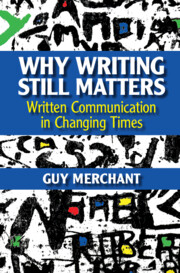Introduction
Published online by Cambridge University Press: 24 August 2023
Summary
The introduction sets out the aims and scope of the book, explaining why this is an important time to take stock of writing – a time in which digital technology is urging us to re-think how we communicate. The chapter argues for thinking about writing as the most developed form of human communication, one that has achieved enormous power and reach. The central idea of the ‘double technology of writing’ is introduced here. Writing combines: a) material technologies of production (pen and ink, keyboard and screen) with b) mnemonic technologies to store and retrieve information. The chapter concludes with an explanation of the sociomaterial approach to writing that is adopted throughout the book.
- Type
- Chapter
- Information
- Why Writing Still MattersWritten Communication in Changing Times, pp. 1 - 14Publisher: Cambridge University PressPrint publication year: 2023

